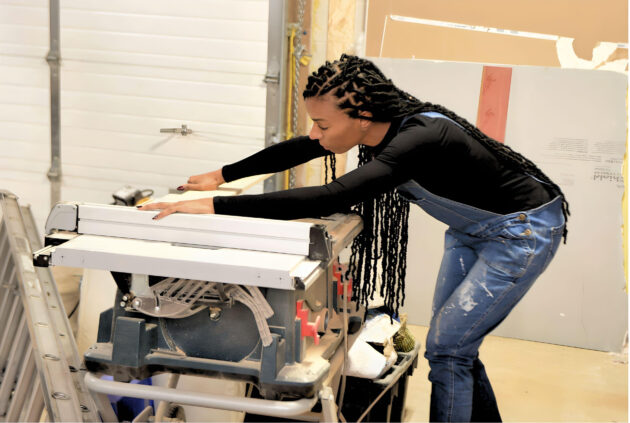Ferguson’s trajectory from daycare apprentice to corporate executive was anything but a straight line.
Natasha Ferguson got her first taste of the trades long before her first day in elementary school. Her father, she says, used to own a number of houses in Toronto, and would often pick her up from daycare and bring her with him to job sites where he would work on one of his properties, recruiting her assistance, where appropriate.
Today, Ferguson is the principal and founder of Ethelfox Construct Group, a successful Toronto-based construction company made up of four divisions: Ethelfox Construct (specializing in interior and exterior renovations), Sky Limitless Roofing, Garden Landscaping, and TKO Demolition.
Ferguson’s trajectory from daycare apprentice to corporate executive was anything but a straight line. In fact, she took quite a detour on her way to running her own construction firm. “I actually never got into the trades right away,” she admits. “After school, I went into corporate communications, and that was my life for about 15 years.”
Eventually, the stressful world of corporate communications took its toll on Ferguson, and she decided that she needed a change. Her husband at the time, was a roofer and a tradesman, so Ferguson decided to start a roofing company with him. “That was back in 2012, and that’s when my journey back into the construction industry picked up again,” she says.
Fortunately, Ferguson had a decade-and-a-half of corporate communications experience under her tool belt, which she put to good use to get her new roofing business off the ground. “I was well versed in how to start a company,” she says, “and that branding experience paid off. I literally just segued—I took what I had learned in the ad world, and I brought it over to construction.”
Her ability to build a brand, and to distinguish her company from others was key to getting the new business off the ground. “There aren’t a lot of well-branded construction companies,” Ferguson explains. “Most contractors don’t even have a website. I knew that going into the industry, and my knowledge about communications and branding was a big win for me.”
When Ferguson wasn’t busy building her brand, she was in the thick of things, working shoulder-to-shoulder with her husband on the roof. “I got up on the roof, and I was really excited about it,” she says. “He taught me a lot about roofing, and that was my life for about three years.”
Soon, however, Ferguson realized that she would need to expand her business and offer more than roofing services. “Since roofing is very seasonal, every winter we’d be poor,” she says. “That meant we’d have to take the worst jobs ever, just to make ends meet. I remember one winter shovelling four feet of snow off someone’s roof and thinking to myself, ‘How did I get myself into this?’”
Sometimes, the reality of the situation was just too much for Ferguson to deal with. “There were times when I would be sitting in the car to get warmed up, and I would just start crying,” she recalls. “I thought to myself, ‘Three years ago I was in high heels and suits, and now I’m dirty and on a roof shoveling snow.’”
While that type of pressure would dissuade many and force them quit, Ferguson doubled down and was determined to continue to grow and to persist in her pursuit of success. Eventually, she took over the business, ran it on her own, and she even hired a roofing crew to do the work.
Landscaping & beyond
That success led her down the path to expanding her business even further. “A few years in, we started getting asked a lot about landscaping,” she recalls. “So I started to teach myself about horticulture, and by that time I had also gotten into hardscaping, and that’s actually one of my favourite trades. So now, we were doing landscaping and hardscaping, and I couldn’t believe how much people were willing to spend on it. We were thriving.”
By 2016, Ferguson says her business was doing very well. She would upsell her roofing customers to buy landscaping or hardscaping, and vice versa. With her corporate communications background, she was able to market her businesses effectively, and she was becoming really well known as the go-to person for siding, roofing, landscape architecture and hardscaping needs. In 2018, Ferguson added renovations to her repertoire of available services.
 Time to refocus
Time to refocus
After coming face-to-face with discrimination and racism, as well as the sense of loss that resulted from the passing of her step-father, and soon thereafter, her mother, Ferguson decided that she needed to refocus and to double-down on her efforts.
Prior to her passing, Ferguson’s mom told her not to be upset when she faced discrimination. Instead, her mom asked her, “Why don’t you do something about it?” Those inspiring words rang true in Ferguson’s ears, and in 2020 she rebranded her company, naming it after her mother and daughter.
Ferguson was also inspired to start a non-profit organization, A Woman’s Work. “It’s the first all-women’s trade school in Canada,” she says. “We launched it last year, and we had 300 women enroll.”
Today, Ferguson is on a roll, going from success to success. “We have over 15 different partnerships with Ellis Don, Local 27, the PDSB [Peel District School Board], Milwaukee Tools,” she adds, “It’s been crazy. We have a training centre running right now in East York, and we are slated to open six more training centres across the GTA [Greater Toronto Area].”
She also has a show in the works, and she has filmed a TV commercial for a well-known retailer. “I have also been given the opportunity, and built a platform, where I advise the government. I’ve literally become the face of women in the trades, and I’m advocating for women in the trades,” she adds.
The bigger picture
Ferguson sees the bigger picture and believes that she may be able to offer a solution to some of the challenges facing the construction industry and the trades in general.
“With all the workers retiring, who is going to fix your toilets or repair your roof?” she asks. “One of the reasons why there are so few people getting into the trades is because we’re not utilizing women and we’re not utilizing the underserved racialized communities. Discrimination runs deep, from local unions to employers, and I can speak to this because I’ve experienced it.”
Her efforts to teach and empower women are key to helping women pursue opportunities in this industry. “We’re teaching women that not only can they be a part of this industry, but they can be entrepreneurs in it,” Ferguson explains. “If I told you that I could teach you how to drywall in eight weeks, and that you can literally go out, patch a few holes, and make $1,200 for the week, that’s empowering.”
The response, thus far, has been impressive. “We put together the classes, we ran our pilot program in November, and it was absolutely amazing,” Ferguson says. “I was featured on Global News, a lot of women came out, I had a pregnant woman there, as well as two women who drove from Montreal to take the course. And believe it or not, I have bootstrapped this entire thing and am funding it myself right now.”
Walking the walk
Not only is Ferguson teaching women about the trades, but she is walking the walk by employing women in her own construction firm. “Sixty per cent of my staff are female,” she says.
She has big plans for the future and hopes to expand her training program to other provinces, as well as into the United States. Moreover, Ferguson believes that we need to rebrand the trades, starting in elementary school.
“We have this idea in our heads that trades people are stupid,” she explains. “You should be in the corporate world, but if you’re dumb, oh, you need to get yourself a trade. But I’ve been in both industries, both corporate, and here, and I can tell you that you need a lot more smarts to do this, because you are problem solving, you’re dealing with clients, and you’re also doing physical work.”
Parents also need to be taught the truth about the trades. “That’s why we’re launching a program for kids,” Ferguson adds. “We’re very excited about it because we want to change the way parents think about blue collar versus white collar. There’s a lot of work to do here, and it’s not going to happen overnight, but one person doing something is better than no people doing anything at all.”
Unlike Ferguson, who was exposed to the wonders of the trades at a very young age, most children today aren’t, and most are taught that the trades are only for those who can’t pursue a corporate job. Moreover, the trades are seldom an option for women, especially women who are discriminated against. Ferguson is hoping to change all that, and if her ability to persist in the face of adversity is any indication, she is likely to succeed in her endeavours.


